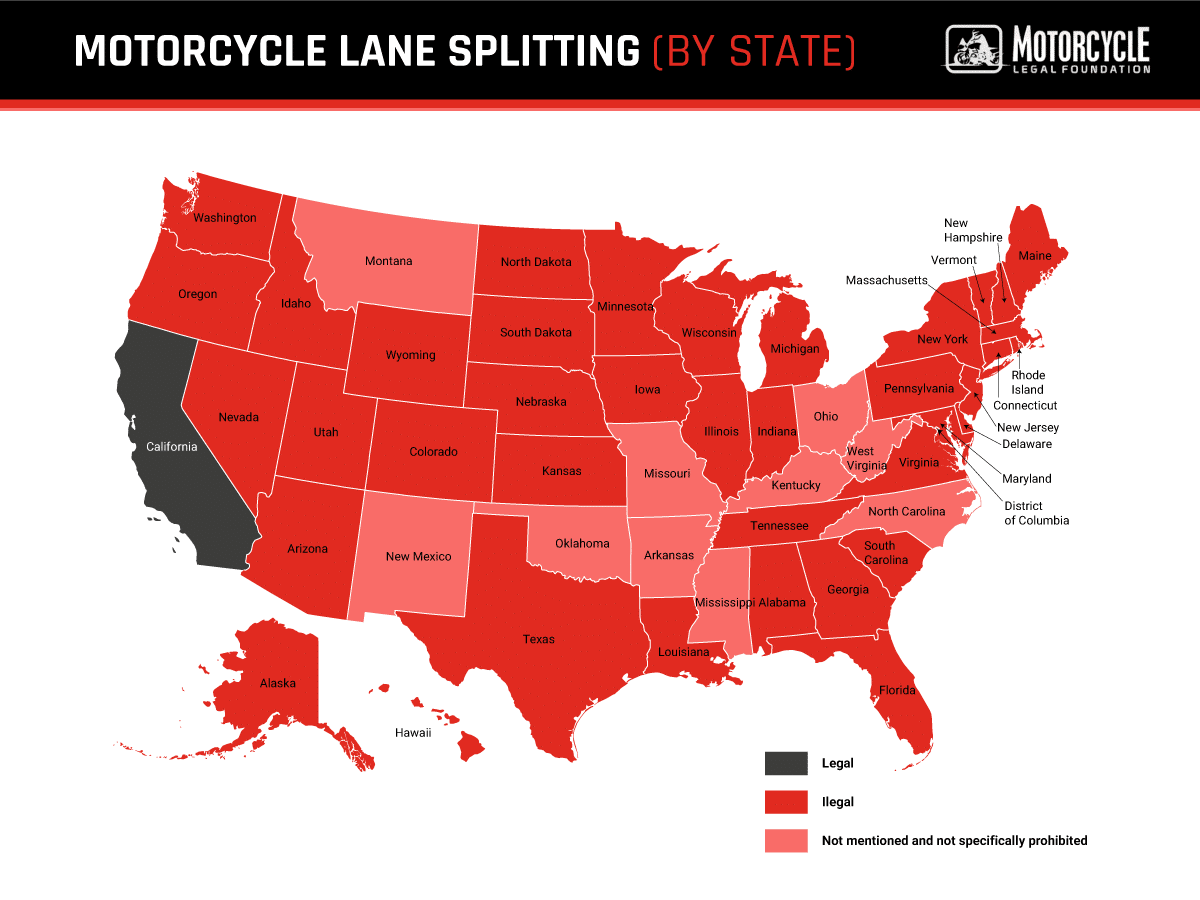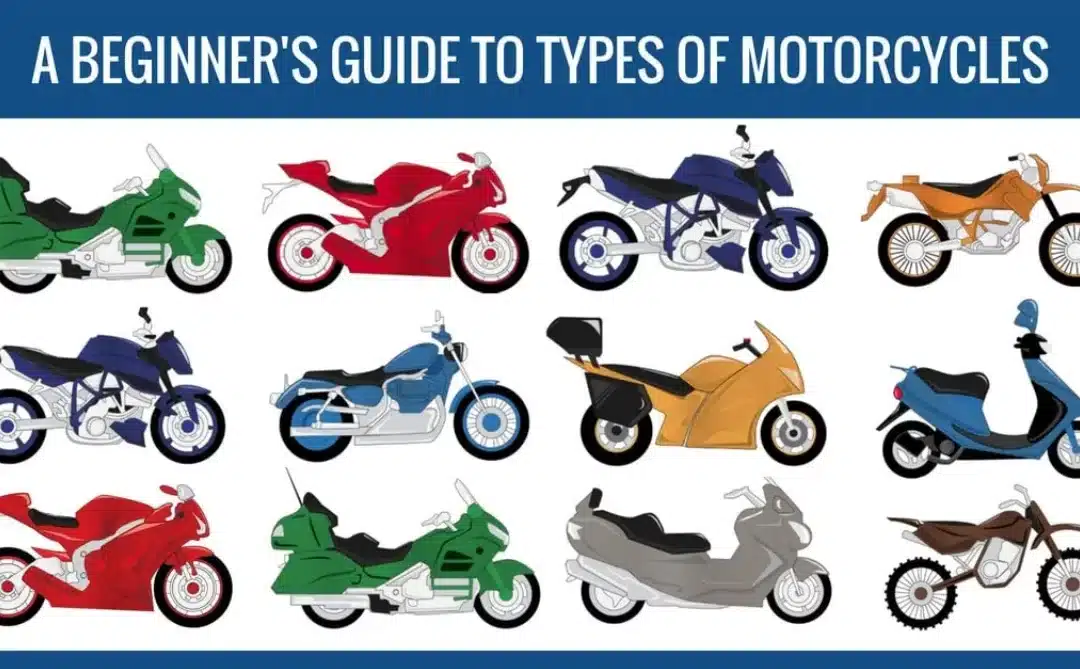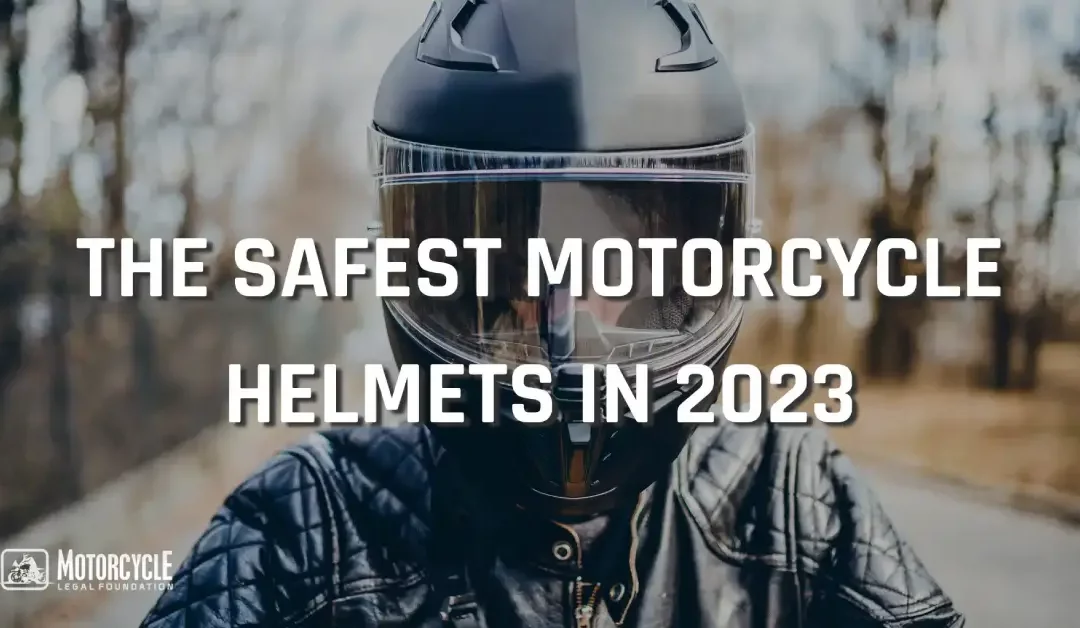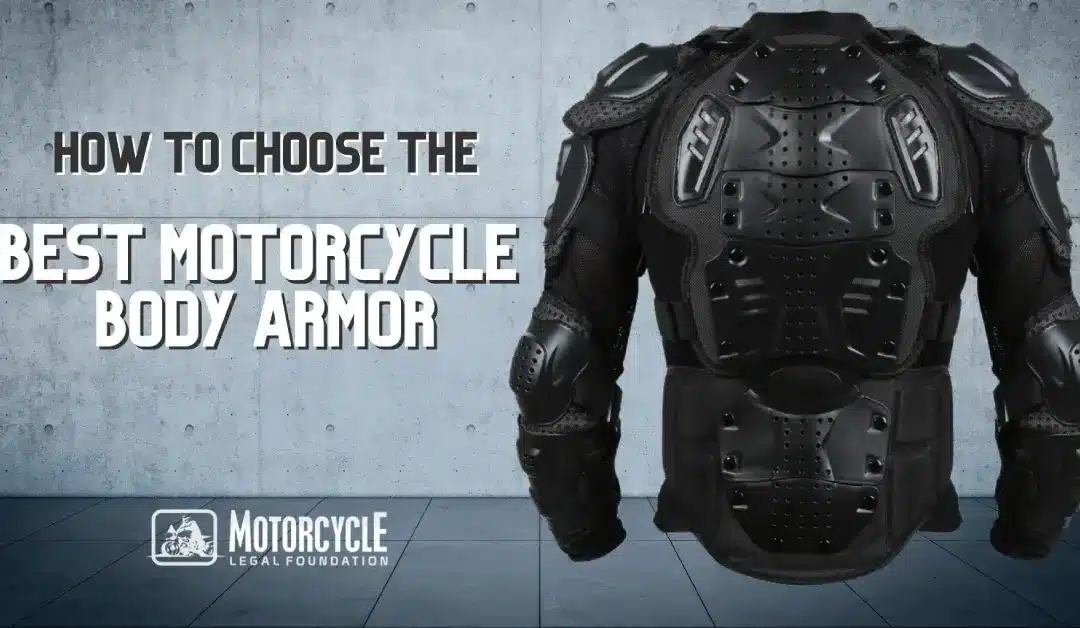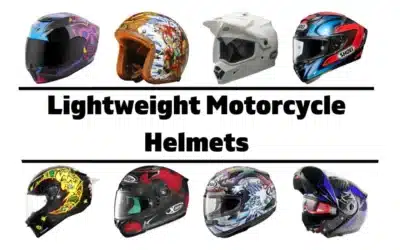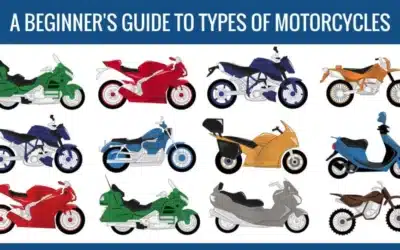Motorcycle lane splitting is the practice of riding a motorbike between two lanes of traffic traveling in the same direction. While this practice is controversial, it has become popular among motorcyclists in recent years as a strategy to minimize traffic congestion and enhance overall traffic flow. Nonetheless, lane splitting may be dangerous, especially if motorcycle riders are not cautious or other cars must be aware of their presence. In this post, we will look at the rules and regulations governing lane splitting into several states and the advantages, hazards, and best practices involved with this activity. In addition, we will address the future of lane splitting and the possibility of other states legalizing the practice. Whether you are a seasoned biker or simply curious about the practice of lane splitting, this article will give you vital facts and insights into this contentious issue.
WHAT IS MOTORCYCLE LANE SPLITTING?
THE LEGAL DEFINITION OF LANE SPLITTING
Lane splitting is a riding technique where a motorcyclist rides between rows of stopped or moving vehicles in the same lane. This technique is officially recognized as legal only in the state of California. According to California’s AB-51, lane splitting is defined as “a motorcycle ridden between rows of stopped or moving vehicles in the same lane including on both divided and undivided streets, roads, or highways.”
THE DIFFERENCE BETWEEN LANE FILTERING, LANE SHARING, AND LANE SPLITTING
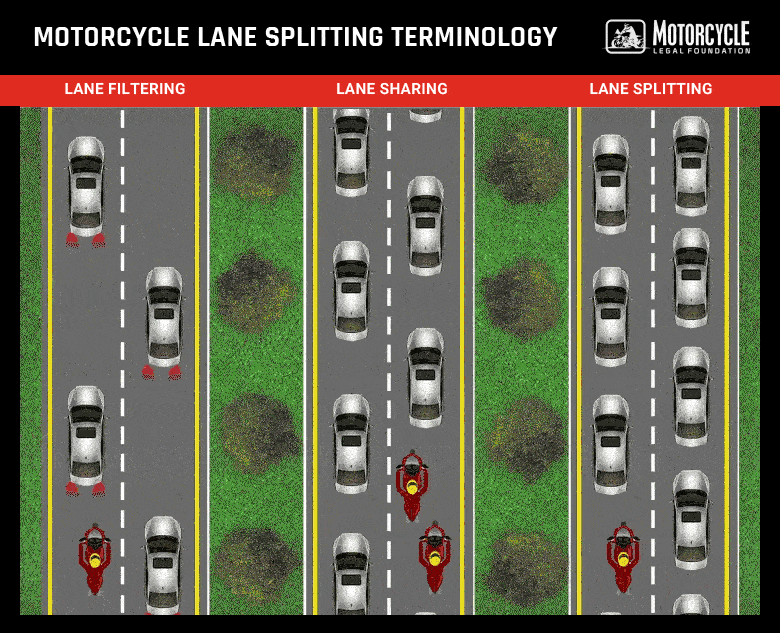
It’s important to note that this definition only applies to California, and the term “lane splitting” has different definitions in other states.
Lane Filtering
The term “lane filtering” is used to refer to a motorcycle picking its way through slow-moving or stationary traffic, such as at a stoplight.
Lane Sharing
Lane sharing covers two riders in the same lane, either side by side or in a staggered formation.
Lane Splitting
Lane splitting, also known as “white lining,” refers to a motorcyclist weaving between moving traffic at a higher speed, usually staying predominantly on the lane dividing line. However, it’s worth noting that this type of riding is considered bad practice and is not endorsed by responsible motorcyclists.
As a general rule of thumb, safe and responsible riding practices are essential when it comes to lane splitting, filtering, and sharing. It’s important to follow the laws and regulations in your state, wear appropriate safety gear, and maintain a safe speed and distance from other vehicles. More importantly, if you don’t feel confident enough to lane split, then you don’t have to. Always prioritize your safety and the safety of others on the road.
BENEFITS AND RISKS OF MOTORCYCLE LANE-SPLITTING
Lane-splitting sparks a divided debate, with proponents highlighting its potential to safely reduce traffic congestion and enhance traffic flow, particularly for motorcyclists aiming to avoid rear-end accidents in slow-moving traffic. Supporters argue that responsible lane splitting can improve traffic conditions for all.
Conversely, opponents view lane splitting as risky, endangering both motorcyclists and other road users due to the high skill and concentration required and the potential for road rage incidents. This safety controversy is ongoing, with varying study outcomes. Ultimately, the decision to lane split should depend on the law, the rider’s skills and experience, responsible practices (including wearing appropriate safety gear, and maintaining safe speeds and distances), and vigilance for potential road hazards.
CAN MOTORCYCLES SPLIT LANES IN AMERICA?
Only one state in the United States has expressly permitted lane splitting, and that’s California. Yet, there are numerous states where the legality of lane splitting has yet to be officially defined.
It’s worth emphasizing that even in places where lane splitting isn’t technically prohibited, it’s up to the Highway Patrol to judge if your behavior is dangerous. This implies you might still obtain a lane-splitting ticket even though your state has no statute against it.
STATE-BY-STATE LAWS ON MOTORCYCLE LANE-SPLITTING
How many states allow lane splitting? We have done some research to find out the legal aspects of motorcycle lane splitting in each state.
California:
California legalized and regulated lane splitting in 2016, defining it as the practice of a motorcycle “riding between rows of stopped or moving vehicles in the same lane.” The state’s guidelines recommend that lane splitting should be done at no more than ten mph above the speed of surrounding traffic and only when it is safe.
Utah:
Utah legalized a regulated form of lane filtering in 2019. Lane filtering allows motorcycles to move between stopped or slow-moving traffic lanes at no more than 15 mph.
Nevada:
Nevada passed Assembly Bill 236 in 2019, allowing the Nevada Department of Transportation to create regulations for motorcycle lane filtering. However, the department has yet to implement any regulations.
Oregon:
Oregon is currently considering House Bill 2314, which would legalize a regulated form of lane splitting. If approved, the bill would allow motorcycles to travel between cars on roadways where the speed limit is 50 mph or greater and traffic is moving at ten mph or slower.
Texas:
Texas is considering House Bill 879, which would legalize and regulate lane splitting. If passed, it would permit motorcycles to move between lanes of stopped or slow-moving traffic at no more than 25 mph.
Hawaii:
Hawaii does not currently allow for any form of lane splitting or filtering. However, the state adopted a regulation in 2018 that permits motorcycle riders to utilize the road shoulders in certain spots to pass stopped vehicles, known as “shoulder surfing.”
Washington:
Washington has Senate Bill 5254 live, legalizing a regulated form of lane splitting. However, the bill has had little to no movement to date.
Maryland:
Maryland has House Bill 917 on deck, legalizing a regulated form of lane splitting. However, there has yet to be any recent movement in the direction of legalization.
Connecticut:
Connecticut has Senate Bill 629 on deck, legalizing a regulated form of lane splitting. However, there has yet to be any recent movement in the direction of legalization.
Montana:
Montana allows for a regulated form of lane filtering, which allows motorcycles to pass stopped or slow-moving traffic at no more than ten mph in the same direction. Additionally, Montana adopted a regulation in 2021 that permits lane splitting under certain conditions, which include ensuring that the road and traffic circumstances are safe, the motorcycle is not moving faster than 20 mph, and the lanes are wide enough.
Arizona:
Arizona Governor Doug Ducey proposed Senate Bill 1273 on March 24, 2022. The measure was signed into law on September 24, 2022. The law allows two-wheeled motorbike riders to pass other cars in the same lane and direction of travel if they are going at 15 miles per hour or less. They are on the road with a speed limit of 45 miles per hour or less and believe the move is safe. This legislation only applies to two-wheel bikes and does not apply to motorcycles with sidecars.
Colorado:
Colorado does not allow for any form of lane splitting or filtering. In addition, the state’s laws explicitly prohibit motorcycles from driving between traffic lanes or adjacent rows of vehicles.
Georgia:
Georgia does not allow for any form of lane splitting or filtering. The state’s laws explicitly prohibit motorcycles from passing between lanes of traffic and require that motorcycles be operated in a permanent and regular seat attached to the motorcycle.
New York:
New York does not allow for any form of lane splitting or filtering. The state’s laws explicitly prohibit motorcycles from overtaking and passing in the same lane occupied by the vehicle being overtaken.
Pennsylvania:
Pennsylvania does not allow for any form of lane splitting or filtering. In addition, the state’s laws explicitly prohibit motorcycles from passing between traffic lanes or adjacent rows of vehicles.
Virginia:
Virginia does not allow for any form of lane splitting or filtering. The state’s laws explicitly prohibit motorcycles from overtaking and passing in the same lane occupied by the vehicle being overtaken.
Need Motorcycle Insurance?
Enjoy your ride while feeling safe with the best insurance coverage.
IS MOTORCYCLE LANE SPLITTING SAFE? SAFETY GUIDELINES
CHP’s Motorcycle Safety Program
- Motorcycles should travel no more than 10 mph faster than their passing traffic.
- Lane splitting should be avoided when traffic is moving at 30 mph or faster to allow for better reaction time.
- Lane splitting improves rider safety by reducing exposure to rear-end collisions and eases traffic congestion.
- The safest lanes to split are between lanes one and two, the far-left lanes.
- Rightmost lanes experience more traffic movement due to on-ramps and exits, making them riskier for lane splitting.
- Riding in the far left lanes allows clear sight over most vehicles, providing a better view of traffic flow ahead.
- When encountering a rider splitting a lane to your right, you should ease back and not ride parallel to them, preventing potential traffic conflicts.
- Lane splitting might appear daunting to inexperienced riders, and it’s important to assess whether you can safely fit through a gap before attempting.
- When two long vehicles are running parallel, waiting for them to reposition before attempting to split the lane is recommended to avoid being trapped.
- Consider the width of your motorcycle from the front, including wide bars, fairing, panniers, forwards, or engine bars.
- Add two extra feet on each side for vehicle wing mirrors and lateral bike movement, considering potential buffeting or raised line markings in tight spaces.
THE FOUR R’S
Whenever the subject of lane splitting is up for discussion, the you should abide by the four R’s.
- Reasonable: Be reasonable with your speed. If you’re weaving too fast through lanes, you’re putting yourself and others in danger.
- Responsible: You are solely responsible for your safety, so make sure your decisions and actions convey this, as it also affects the people that surround you.
- Respectful: Mind other road users. Safely acknowledge someone who gives you extra room prior to lane splitting. Remember, although you may be legally allowed to split, other road users aren’t legally obliged to make space for you.
- Roadways: Beware of roadways for when it is combined with traffic, it can equate to potential danger. You need to be super aware of poor and uneven surfaces, wide vehicles, inattentive drivers, and poor weather while riding in heavy traffic.
It, therefore, stands to reason that it’s important to stay focused at all times in order to respond to any potential dangers. Remember to stay alert, be sensible, and if it feels wrong, ease back.
DO’S AND DON’TS OF LANE SPLITTING
We’d like to preface this section with the notion that we encourage you to always abide by the laws of the road in your respective State.
- DON’T make drivers over-react. If you ride too fast, all they’re going to see is something flash-by in their peripheral vision.
- DO stay in a gear that keeps the revs low. Both of these actions may cause a distracted driver to swerve.
- DON’T be physically prepared without being mentally prepared for riding between traffic. Yes, your survival instinct needs to be on full alert, but do ride with a positive, mental attitude.
- DO be aware of splitting in wet conditions. Riding on painted lines reduces grip when it rains.
- DON’T think that the law protects you from riding badly. Bill AB-51/21658.1 makes the physical act of lane splitting legal under set circumstances and CVC 22400 makes it illegal for drivers to block or impede a motorcyclist. These facts, however, don’t preclude anyone from extending common courtesy to other road users when executing the maneuver, so do be courteous!
- DO watch out for lumps, bumps, and uneven surfaces as they can upset the handling of your bike.
- DON’T lane share at night or in the dark. Lane sharing in the dark could confuse divers into making them think you are a four-wheeled vehicle rather than a two-wheeled vehicle.
From a motorcyclist’s point of view, lane splitting saves time, eases congestion, and keeps them out of harm’s way. According to Rob Dingman, President, and CEO of the American Motorcyclist Association, “Lane splitting keeps riders safer by eliminating their exposure to rear-end collisions, and it helps ease congestion by effectively removing motorcycles from the traffic lanes.”
In conclusion, motorcycle lane splitting has become a hot topic among riders and policymakers, with many states considering or already implementing guidelines and regulations for this practice. While lane splitting can provide benefits such as reducing traffic congestion and increasing rider safety, it also poses risks if done improperly.Our safety guidelines aim to provide riders with clear and concise recommendations for safely lane splitting, emphasizing the importance of maintaining a safe speed, being aware of surroundings, and utilizing proper protective gear. By following these guidelines and advocating for responsible and safe riding practices, motorcyclists can help promote the adoption of lane-splitting legislation across the country. As always, it is essential to prioritize safety and awareness on the road, regardless of whether or not lane splitting is legal in a particular state.
Need Motorcycle Insurance?
Enjoy your ride while feeling safe with the best insurance coverage.

